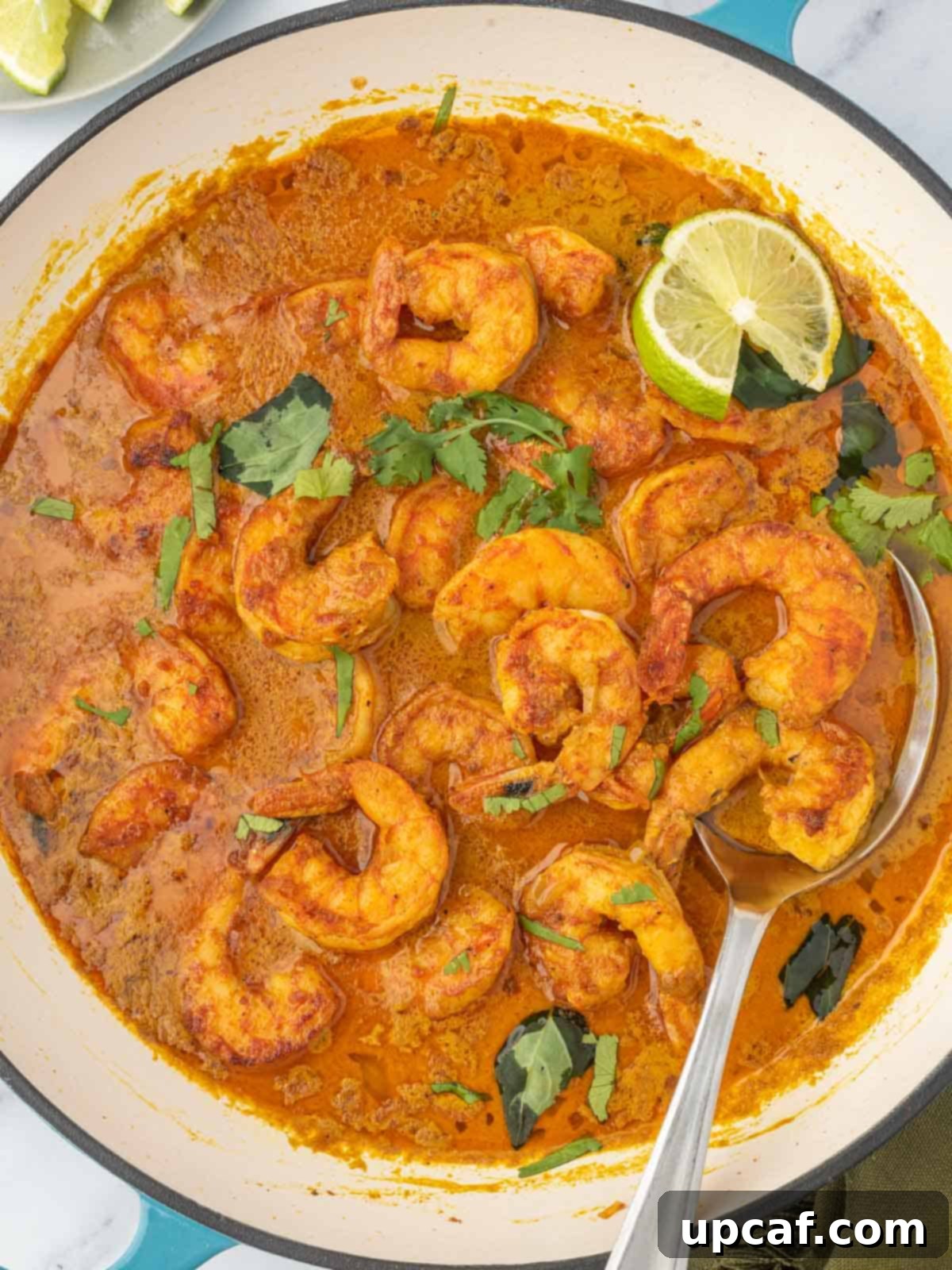Welcome to the ultimate guide for crafting a truly exceptional Thai Coconut Shrimp Curry! This vibrant, creamy, and mildly spicy dish brings the authentic flavors of Thailand right into your kitchen. Imagine succulent jumbo shrimp immersed in a rich, aromatic red curry sauce, infused with the sweetness of coconut milk and the fresh zest of Thai basil. This recipe isn’t just delicious; it’s incredibly fast, making it a perfect solution for a flavorful weeknight dinner that the entire family will adore. Forget lengthy preparation; this culinary delight is ready to serve in under 30 minutes, proving that gourmet taste doesn’t have to demand hours of your time.
Our Thai Coconut Shrimp Curry recipe simplifies the complex layers of Thai cuisine into an accessible and rewarding cooking experience. The sauce is a harmonious blend of fragrant red curry paste, the lusciousness of full-fat coconut milk, a touch of savory soy sauce, and a generous scattering of fresh Thai basil, which not only adds a burst of color but also an unforgettable aromatic profile. Served over fluffy basmati rice, this curry transforms ordinary ingredients into an extraordinary meal that’s both comforting and exotic.
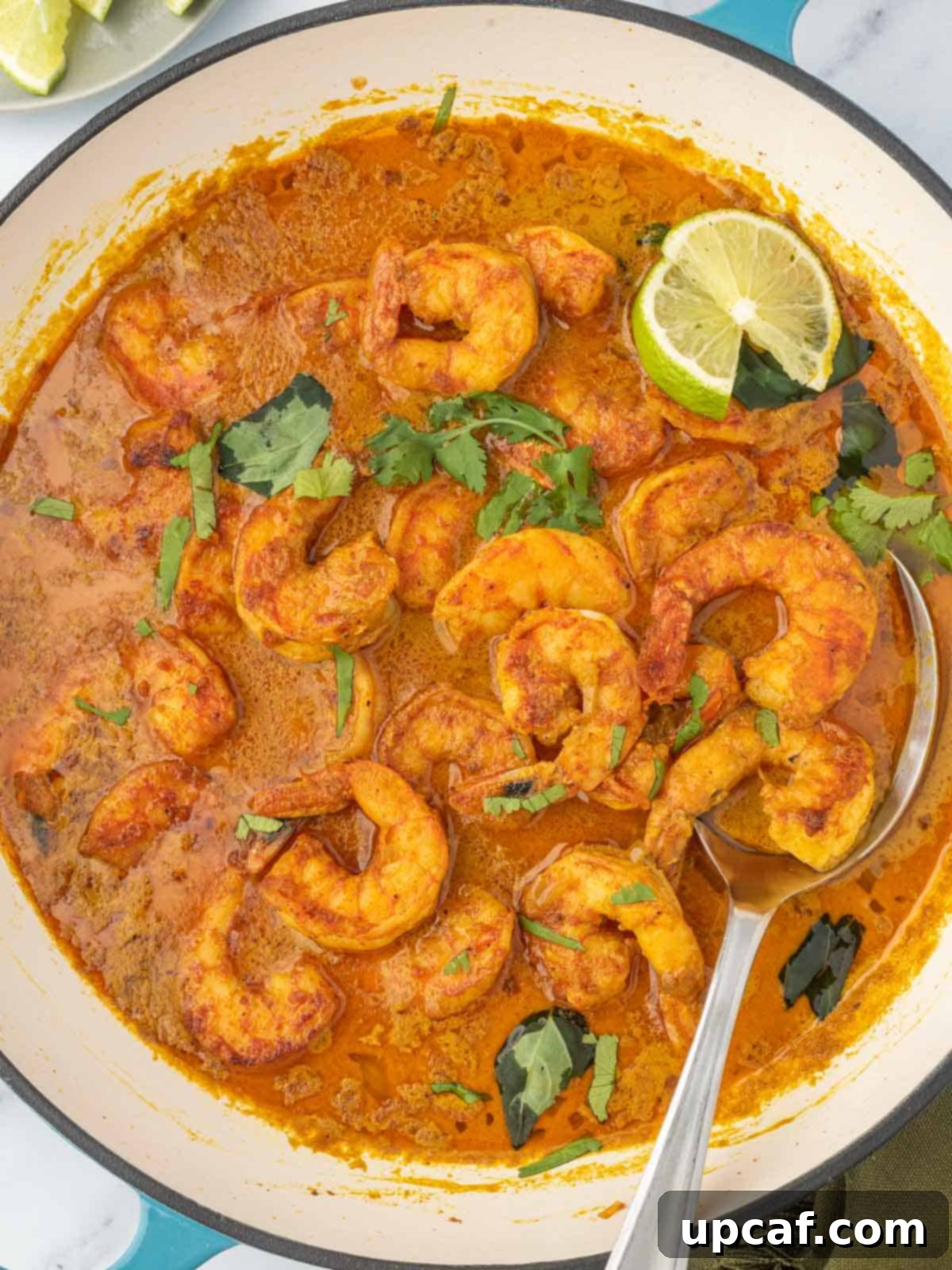
This red curry shrimp dish strikes the perfect balance: it’s rich and satisfying enough to impress guests, yet straightforward enough for a casual family meal. Every spoonful is packed with a depth of flavor that will have everyone licking their plates clean. If you’re a true curry enthusiast, we highly recommend exploring other delightful variations like our Red Thai Vegan Curry for a plant-based option or the hearty Thai Red Curry Chicken for another protein choice. But for now, let’s dive into what makes this Coconut Shrimp Curry an absolute must-try.
Why This Thai Coconut Shrimp Curry Will Become Your Go-To Recipe
There are countless reasons to fall in love with this Thai Coconut Shrimp Curry. It’s more than just a meal; it’s an experience that brings comfort, flavor, and convenience together. Here’s why this recipe stands out:
- Authentic and Rich Flavor Profile: At the heart of any great Thai curry is a harmonious blend of spices and aromatics. This recipe uses a high-quality red curry paste and rich coconut milk, which are the cornerstones of traditional Thai curries. The result is a creamy, complex, and deeply satisfying flavor that tastes genuinely authentic, transporting your taste buds straight to the bustling streets of Bangkok. The combination of sweet, savory, and mildly spicy notes creates a perfectly balanced and incredibly addictive sauce that you’ll crave again and again.
- Remarkably Quick and Easy: In today’s fast-paced world, finding time to cook a delicious and healthy meal can be a challenge. This Thai Red Curry Shrimp is a lifesaver, coming together in less than 30 minutes from start to finish. This includes all the prep work, from seasoning the shrimp to simmering the luscious sauce. It’s quicker than ordering takeout and significantly more rewarding, making it an ideal choice for busy weeknights when you need a wholesome meal without the fuss.
- A Complete and Wholesome Meal: Served alongside a generous portion of fluffy rice, this shrimp curry is a filling yet light meal that provides a balanced nutritional profile. The protein-rich shrimp, combined with the healthy fats from coconut milk and the complex carbohydrates from rice, ensures you feel satisfied without feeling heavy. It’s a complete meal that caters to diverse tastes, making it a guaranteed crowd-pleaser for the whole family, even picky eaters. You can also easily enhance its nutritional value by adding your favorite vegetables.
- Versatile and Adaptable: While shrimp is the star of this dish, the recipe is incredibly versatile. You can easily swap out the shrimp for other proteins like chicken, firm tofu, or even a medley of vegetables to suit different dietary preferences or what you have on hand. It’s a forgiving recipe that allows for creativity and customization without compromising on flavor, making it a flexible staple in your culinary repertoire.
Essential Ingredients for Your Perfect Thai Shrimp Curry
Creating an exquisite Thai Coconut Shrimp Curry starts with selecting the right ingredients. Each component plays a vital role in building the dish’s signature flavor and texture. Here’s a detailed look at what you’ll need and tips for choosing the best:

For the Flavorful Shrimp
- Shrimp: Opt for jumbo shrimp, preferably peeled and deveined to save time. Leaving the tails on enhances presentation and adds a touch of visual appeal, but feel free to remove them if you prefer. Fresh or frozen (and thawed) shrimp both work wonderfully, just ensure they are of good quality.
- Red Curry Paste: This is the cornerstone of the dish’s Thai flavor. A good quality red curry paste is a fragrant, well-seasoned chili paste that provides a complex heat and depth. Look for brands with authentic ingredients for the best results.
- Soy Sauce: A touch of soy sauce adds umami and seasoning to the shrimp. Use low-sodium soy sauce to better control the overall saltiness of the dish. For a gluten-free alternative, tamari or coconut aminos are excellent substitutes.
- Curry Powder: While red curry paste is primary, a dash of curry powder amplifies the flavor and, thanks to turmeric, imparts a beautiful golden hue to the shrimp, making it even more appealing.
- Salt and Black Pepper: Basic seasonings to enhance the natural taste of the shrimp and balance the other spices. Adjust to your personal preference.
- Olive Oil: Used for sautéing the shrimp. Any light, neutral-flavored oil like canola, vegetable, or avocado oil would also work.
For the Rich Coconut Curry Sauce
- Unsalted Butter: Starting the sauce with unsalted butter allows you to control the seasoning precisely, adding richness and a velvety texture to the base.
- Aromatics (Garlic, Ginger, Shallot): The trifecta of freshly minced garlic, grated ginger, and finely chopped shallot forms the aromatic foundation of the sauce, providing layers of pungent, spicy, and sweet notes that are absolutely essential for an authentic flavor. Fresh is always best here!
- Chicken Broth: This liquid helps deglaze the pan and forms the base of the sauce. Low-sodium chicken broth is recommended. Vegetable broth or even water can be used as a substitute, especially for a vegetarian version.
- Red Curry Paste: Another generous spoon of red curry paste for the sauce ensures a robust and consistent Thai flavor throughout the dish.
- Soy Sauce: Similar to the shrimp seasoning, soy sauce in the sauce contributes umami. Again, low-sodium is preferred.
- Brown Sugar: A critical ingredient for balancing the spice and acidity, brown sugar adds a touch of caramel-like sweetness, rounding out the complex flavors of the curry. Honey can be used as an alternative.
- Dry Seasonings (Curry Powder, Coriander Powder, Turmeric Powder, Salt, Black Pepper): This blend of spices further deepens the flavor profile and contributes to the beautiful color of the sauce. Turmeric, in particular, is known for its vibrant yellow pigment and earthy notes.
- Full-Fat Canned Coconut Milk: This is non-negotiable for a creamy, luscious Thai curry. Always use full-fat canned coconut milk, which is thick and rich. Avoid the thinner, refrigerated coconut milk designed for drinking, as it will not provide the desired consistency or richness.
- Fresh Lime Juice: A squeeze of fresh lime juice at the end is crucial. Its bright acidity cuts through the richness of the coconut milk and curry, uplifting all the flavors and adding a refreshing finish.
- Thai Basil: Fresh basil is a must for both flavor and aromatic complexity. Thai basil offers a distinct, slightly peppery and anise-like flavor that is characteristic of Thai cuisine. If unavailable, regular sweet basil can be used, though the flavor will be slightly different.
- Fresh Cilantro: Chopped cilantro serves as a fresh, bright garnish, adding an herbaceous counterpoint to the rich curry.
- Lime Wedges: Essential for serving, allowing diners to add an extra burst of fresh citrus to their individual portions.
Step-by-Step Guide: Crafting Your Delicious Thai Shrimp Curry
Follow these simple steps to create a show-stopping Thai Coconut Shrimp Curry in no time. This method ensures maximum flavor and perfectly cooked shrimp every single time.
- Prepare and Season the Shrimp: Begin by patting the jumbo shrimp thoroughly dry with a kitchen towel. This step is crucial for achieving a good sear. In a mixing bowl, combine the dried shrimp with 1 tablespoon of red curry paste, 1 teaspoon of soy sauce, 1 teaspoon of curry powder, ½ teaspoon of salt, and ¾ teaspoon of black pepper. Toss vigorously until each shrimp is evenly coated with the aromatic seasoning blend. Set aside.
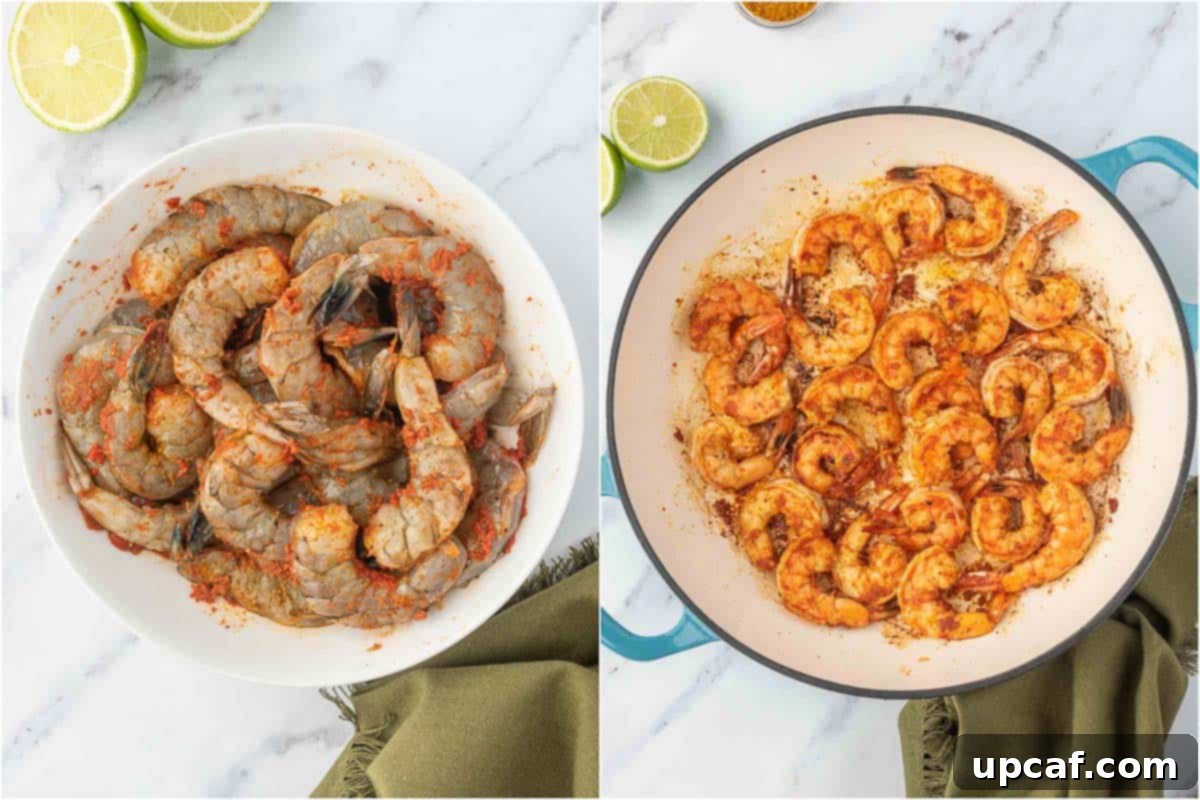
- Sauté the Shrimp to Perfection: Heat 1 tablespoon of olive oil in a large skillet or wok over medium-high heat until shimmering. Once the oil is hot, add the seasoned shrimp in a single layer, being careful not to overcrowd the pan. Cook for approximately 4-5 minutes, flipping once, until the shrimp turn pink and opaque, indicating they are cooked through. Remove the cooked shrimp from the skillet and transfer them to a plate; set aside for later. Avoid overcooking, as shrimp can become rubbery quickly.
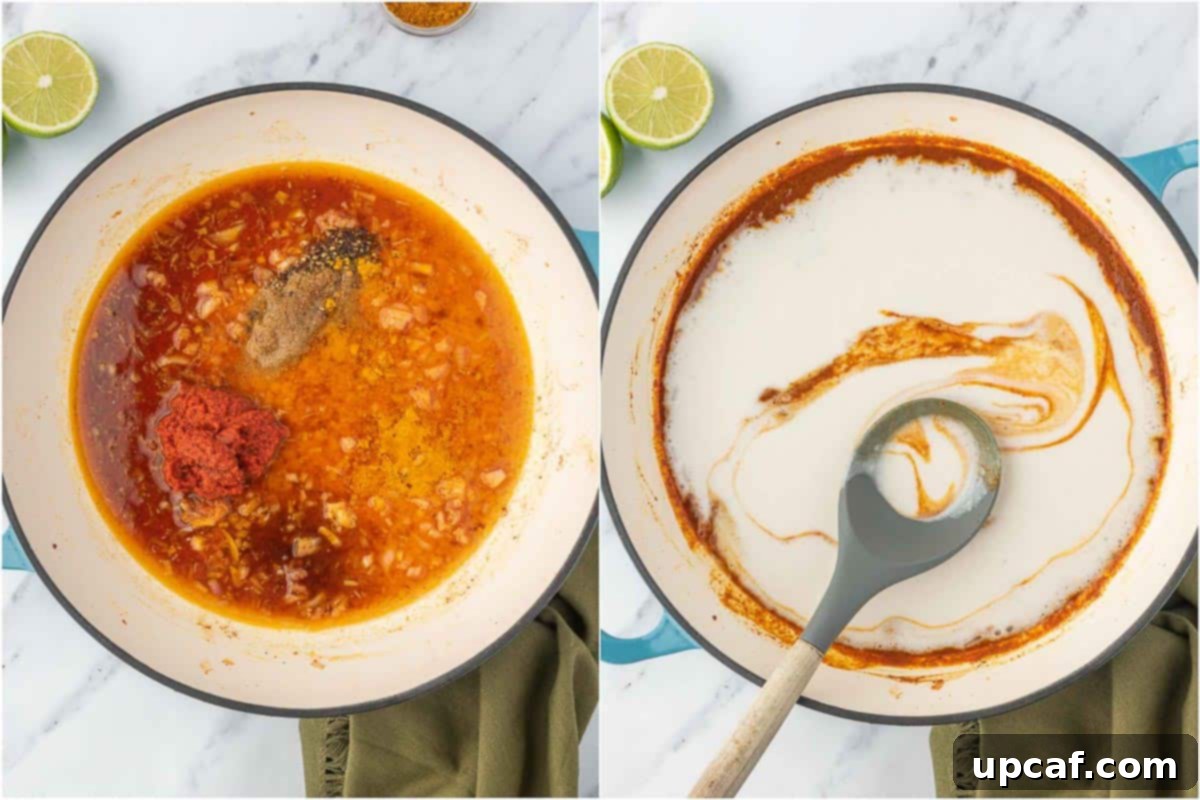
- Cook the Aromatics: Using the same skillet, reduce the heat to medium. Add 1 tablespoon of unsalted butter and allow it to melt. Once melted, add the minced garlic, grated ginger, and finely chopped shallot to the pan. Sauté for about 2 minutes, stirring frequently, until the aromatics are fragrant and the shallots have softened, releasing their sweet aroma.
- Deglaze and Build the Base: Pour ¾ cup of low-sodium chicken broth into the skillet to deglaze the pan, scraping up any flavorful browned bits from the bottom. Stir in 2½ tablespoons of red curry paste and 2 tablespoons of soy sauce, ensuring they are well combined with the broth and aromatics.
- Infuse with Spices and Sweetness: Add 1 tablespoon of brown sugar, 1 teaspoon of curry powder, 1 teaspoon of coriander powder, ½ teaspoon of turmeric powder, ½ teaspoon of salt, and ½ teaspoon of black pepper to the sauce. Stir everything together and allow it to simmer gently for 2-3 minutes, letting the flavors meld and deepen.
- Add Coconut Milk and Thicken the Sauce: Carefully pour in the entire can (14 oz.) of full-fat coconut milk. Bring the sauce to a gentle boil, then immediately reduce the heat to low and allow it to simmer for about 5 minutes. During this time, the sauce will gently thicken to a beautiful, creamy consistency, ready to envelop your shrimp.

- Return Shrimp to Curry: Gently transfer the previously cooked shrimp back into the skillet with the simmering coconut curry sauce. Allow the shrimp to heat through and absorb the curry flavors for just 2 minutes. Remember, the shrimp are already cooked, so this step is just to warm them up and integrate them into the sauce.
- Final Touches and Garnish: Remove the skillet from the heat. Stir in 1 tablespoon of fresh lime juice and the 5-6 Thai basil leaves. The fresh lime brightens the entire dish, and the basil adds a final fragrant touch. Serve immediately, garnished generously with chopped fresh cilantro and alongside lime wedges for an extra squeeze of citrus.
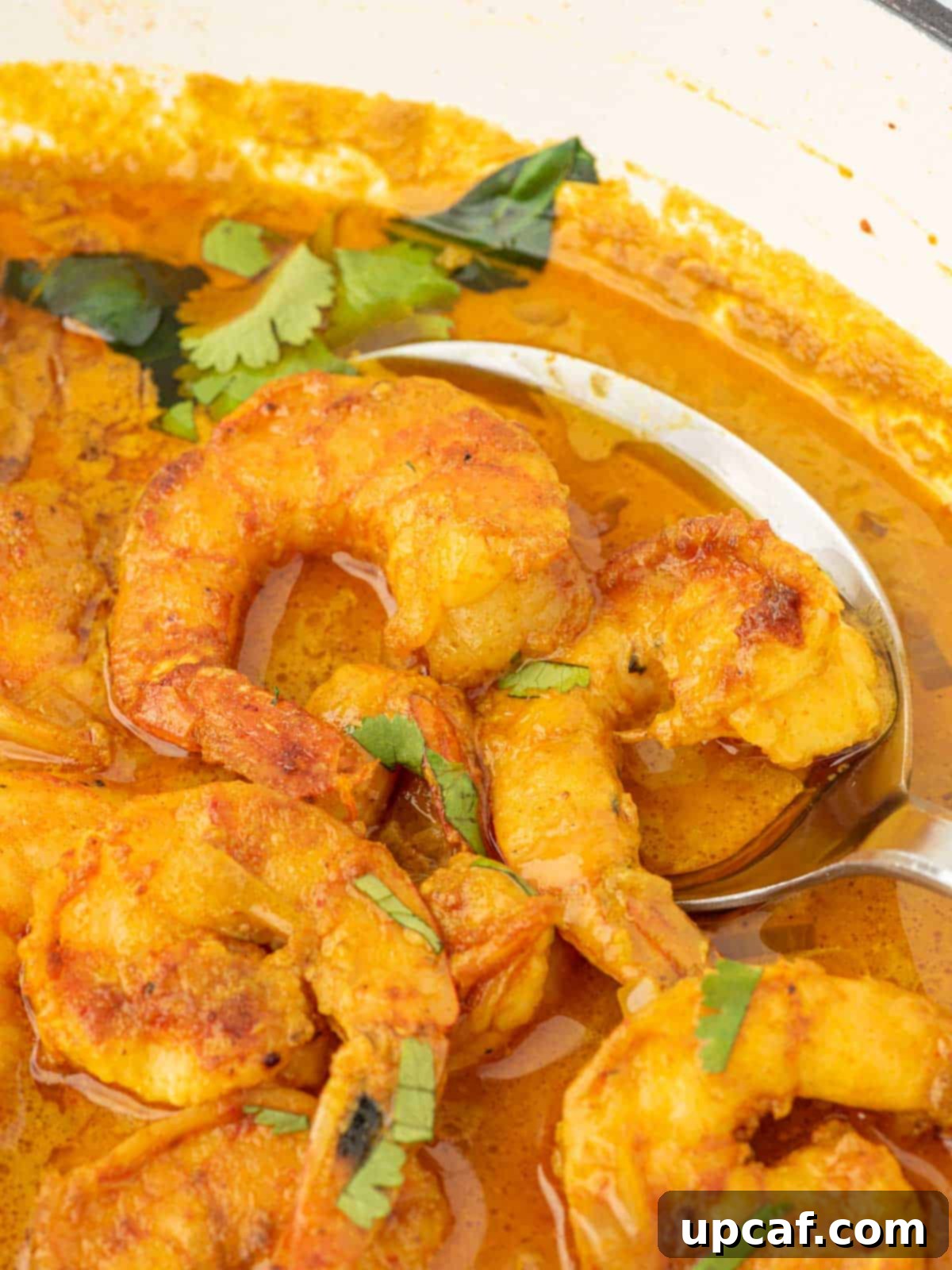
Expert Tips for the Best Coconut Shrimp Curry
Achieving the perfect Thai Coconut Shrimp Curry is easy with a few simple tricks. These tips will help you maximize flavor and ensure a consistently delicious result every time you cook this dish:
- Thoroughly Dry Your Shrimp: Before seasoning the shrimp, always pat them completely dry with paper towels. Excess moisture can prevent the shrimp from searing properly, leading to a steamed rather than beautifully browned texture and hindering the adherence of seasonings.
- Mind Your Sodium Levels: When using soy sauce and chicken broth, opt for low-sodium versions. This gives you greater control over the saltiness of the dish, allowing you to adjust it precisely to your taste without risking an overly salty outcome.
- Choose Full-Fat Coconut Milk: For a truly rich, creamy, and authentic Thai curry, full-fat canned coconut milk is essential. The higher fat content contributes to the luscious texture and deep flavor profile that distinguishes a good curry. Avoid light coconut milk or coconut beverages, as they are too thin and may curdle.
- Do Not Overcook the Shrimp: Shrimp cooks incredibly quickly. Overcooked shrimp become tough, rubbery, and lose their delicate flavor. Cook them just until they turn pink and opaque, then remove them from the heat. They will continue to cook slightly when added back to the hot curry sauce.
- Tail On or Off?: Leaving the tails on shrimp can enhance the visual presentation of the dish, making it look more appealing and restaurant-quality. However, for ease of eating, especially for children, feel free to remove the tails. It’s purely a matter of preference.
- Adjust the Heat to Your Liking: If you prefer a spicier curry, there are several ways to kick up the heat. Consider adding a pinch of red pepper flakes, a teaspoon of Sambal Oelek (a popular chili garlic sauce), or a dash of sriracha to the sauce while it simmers. Start with a small amount and taste, adding more as desired.
- Always Use Fresh Garlic and Ginger: Garlic and ginger are fundamental to the aromatic base and distinctive flavor of this Thai curry. While pre-minced versions are convenient, fresh garlic and grated ginger offer a far superior, more vibrant, and pungent flavor that truly elevates the dish.
- Boost with Vegetables: To make this dish even more robust and nutritious, consider sautéing some vegetables along with your aromatics. Bell peppers, snap peas, broccoli florets, zucchini, or mushrooms are excellent additions that absorb the curry flavors beautifully and add texture.
- Vegetarian Adaptation: For a delicious vegetarian or vegan version, simply replace the shrimp with firm tofu (pressed and cubed), chickpeas, or a medley of your favorite vegetables. Ensure you use vegetable broth instead of chicken broth for a fully plant-based meal.

Frequently Asked Questions About Thai Coconut Shrimp Curry
Here are answers to some common questions about making and enjoying Thai Coconut Shrimp Curry:
For the best results and an authentic creamy texture, always use full-fat canned coconut milk. This type of coconut milk is rich and thick, providing the essential body and flavor for your curry. Avoid using low-fat coconut milk or the thinner, refrigerated coconut milk found in the dairy section, as these can result in a watery curry and are more prone to separating or curdling when heated.
Absolutely! Adding vegetables is a fantastic way to enhance the nutrition and volume of your curry. You can sauté hardy vegetables like sliced onions, bell peppers (any color), or carrots along with the garlic, ginger, and shallots. Other great additions include broccoli florets, snow peas, sliced zucchini, baby corn, or bamboo shoots, which can be added with the coconut milk to simmer. Spinach or chopped kale can be stirred in at the very end until wilted. Feel free to use whatever fresh vegetables you have on hand to make it a more complete meal.
Yes, you certainly can! Thai curry pastes come in several varieties, most commonly red, green, and yellow, each with its own distinct flavor profile and spice level. Green curry paste is typically the spiciest and has a fresh, herbaceous flavor from green chilies and herbs like kaffir lime. Red curry paste is usually moderately spicy with a richer, more robust flavor. Yellow curry paste is generally milder and sweeter. Choose the curry paste you like best based on your preferred flavor and heat level, and use it as a direct substitute for the red curry paste in this recipe.
Leftover Thai Coconut Shrimp Curry can be stored safely in an airtight container in the refrigerator for up to 3 days. To reheat, you can warm it gently in the microwave in short bursts, stirring occasionally, or reheat it on the stovetop in a skillet over medium-low heat until it is warmed through. If the sauce has thickened too much during storage, you can add a splash of chicken broth or water to achieve the desired consistency while reheating.
Yes, Coconut Shrimp Curry freezes quite well, making it an excellent option for meal prepping. Allow the curry to cool completely to room temperature before transferring it to an airtight, freezer-safe container. It can be stored in the freezer for up to 3 months. When you’re ready to enjoy it, thaw the curry overnight in the refrigerator. Reheat gently in the microwave or on the stovetop, adding a bit of broth or water if needed to restore its original consistency.
This versatile Coconut Shrimp Curry pairs wonderfully with a variety of sides. Traditionally, it’s served over fluffy basmati rice or jasmine rice, which beautifully soaks up the rich sauce. For low-carb options, consider serving it with Cauliflower Rice. Other excellent accompaniments include warm flatbreads like Keto Naan Bread to scoop up the sauce, a refreshing side salad such as Spinach Chickpea Salad, or a simple green salad dressed with a light vinaigrette. Steamed or stir-fried vegetables also make a great addition.
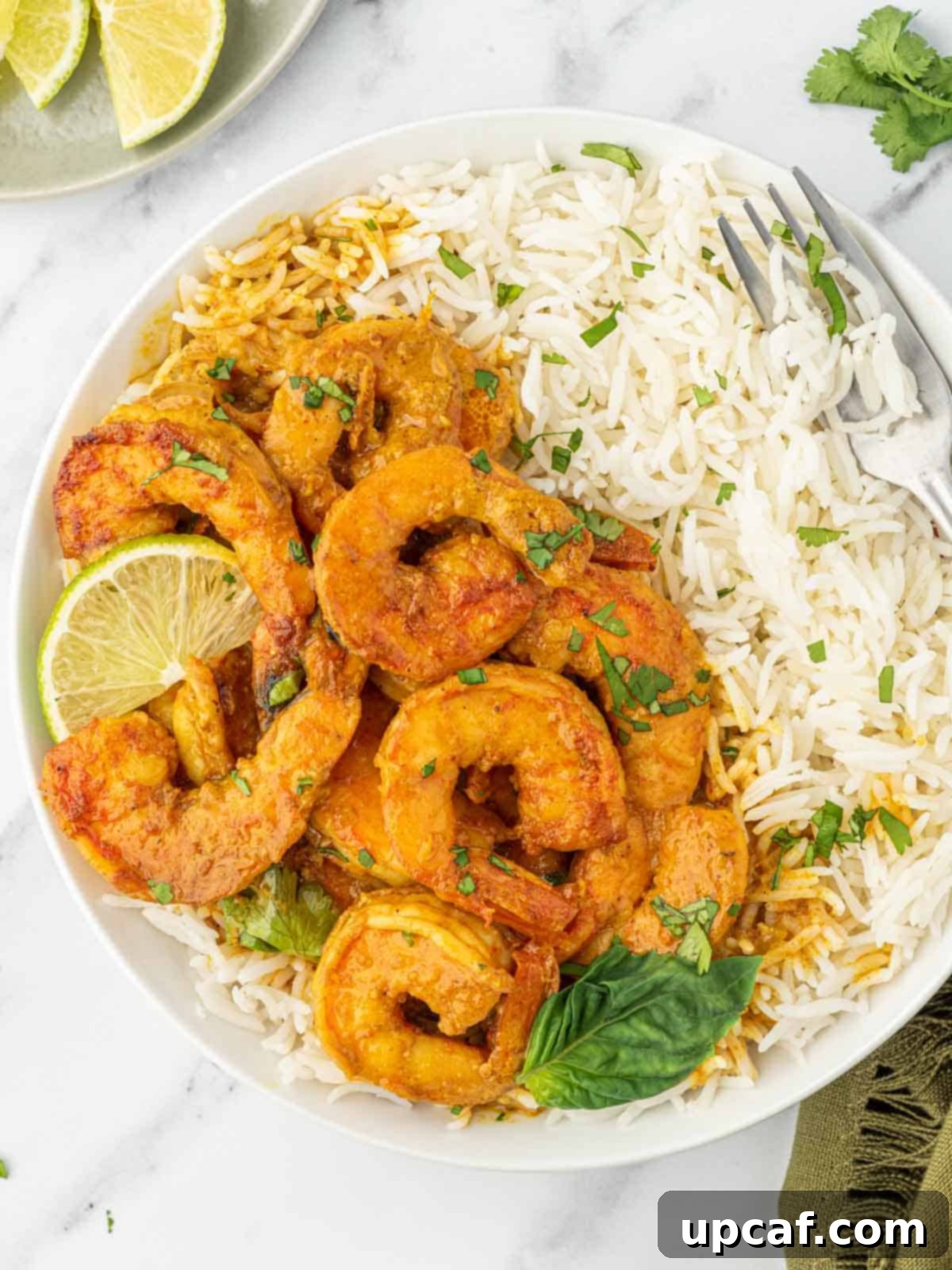
Explore More Delicious Shrimp Recipes
If you’ve enjoyed the delightful flavors of this Thai Coconut Shrimp Curry, you’re in for a treat! Shrimp is an incredibly versatile ingredient, perfect for quick and flavorful meals. Here are more fantastic shrimp recipes to add to your culinary repertoire:
- Grilled Garlic Shrimp Skewers: Perfect for summer grilling or a quick oven bake, these skewers are packed with garlicky flavor.
- Kung Pao Shrimp Recipe: A classic takeout favorite, made healthier and faster at home with succulent shrimp and a spicy, savory sauce.
- Shrimp Sushi Stack: A fun and creative way to enjoy sushi flavors without the rolling, featuring layers of seasoned rice and fresh shrimp.
- Easy Buffalo Shrimp: Get all the tangy, spicy flavor of buffalo wings in a lighter, seafood-friendly form.
- Chili Lime Shrimp: A bright and zesty dish that brings together the perfect balance of heat and citrus, ideal for tacos or salads.
- Shrimp Lettuce Salad: A refreshing and light salad, perfect for a healthy lunch or a warm evening meal.
- Firecracker Shrimp: Explosively flavorful shrimp coated in a sweet and spicy sauce that’s sure to impress.
We truly hope you enjoy mastering this delectable Coconut Curry Shrimp recipe. It’s a dish that promises rich flavors, comforting warmth, and the ease of a quick weeknight meal. Please give it a try, savor every bite, and share your experience with friends and family! Your ratings and comments mean the world to us.
If you find joy in this recipe, consider leaving a star rating and a comment below to let us know your thoughts. For all our latest culinary creations and social updates, be sure to follow Cookin’ With Mima on FACEBOOK | INSTAGRAM | PINTEREST.
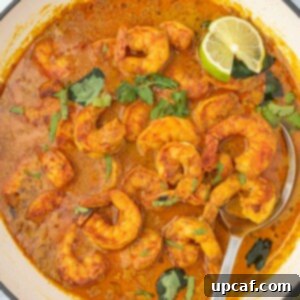
Print Recipe
Thai Coconut Shrimp Curry
Ingredients
For the shrimp
- 1.5 lb jumbo shrimp, peeled and deveined, tail ON
- 1 tablespoon red curry paste
- 1 teaspoon soy sauce
- 1 teaspoon curry powder
- ½ teaspoon salt, or more to taste
- ¾ teaspoon black pepper
- 1 tablespoon olive oil
For the curry
- 1 tablespoon unsalted butter
- 1 teaspoon garlic, minced
- 1 teaspoon ginger, grated
- 1 shallot, finely chopped
- ¾ cup chicken broth, low sodium
- 2½ tablespoons red curry paste
- 2 tablespoons soy sauce
- 1 tablespoon brown sugar
- 1 teaspoon curry powder
- 1 teaspoon coriander powder
- ½ teaspoon turmeric powder
- ½ teaspoon salt
- ½ teaspoon black pepper
- 1 can full fat coconut milk, 14 oz.
- 1 tablespoon fresh lime juice
- 5-6 Thai basil leaves
- Chopped cilantro, to garnish
- Lime wedges, to serve
Instructions
- Pat dry the shrimp with a kitchen towel and season the shrimp with red curry paste, soy sauce, curry powder, salt, and black pepper. Toss it until well combined.
- Heat a skillet over medium heat; add oil and once the oil is heated add the seasoned shrimp and cook for 4-5 minutes until the shrimp is cooked through and opaque. Transfer the shrimp to a plate and set it aside.
- To the same skillet, add the butter; once the butter is melted, add garlic, ginger, and shallots. Cook for 2 minutes until onions are soft.
- Deglaze the skillet with chicken broth and stir in the red curry paste and soy sauce.
- Add the spices; brown sugar, curry powder, coriander powder, turmeric powder, salt, and pepper. Let it simmer for 2-3 minutes.
- Pour in the canned coconut milk and bring the sauce to a boil. Lower the heat and allow the sauce to simmer for 5 minutes until the sauce starts to thicken.
- Transfer the shrimp back to the skillet and allow the shrimp to cook for 2 minutes in the curry.
- Add lime juice and Thai basil and remove the skillet from the heat.
- Garnish the coconut shrimp curry with cilantro and serve it over basmati rice to enjoy.
Notes
- Dry the shrimp on paper towels before adding the seasonings.
- Use low sodium soy sauce to control the saltiness.
- Use full fat coconut milk.
- Shrimp cook quickly, so take care not to overcook it.
- I prefer to leave the tails on for presentation, but you can remove them if you prefer.
- Add heat by adding red pepper flakes, Sambal Oelek or sriracha to the sauce.
- Garlic and ginger are essential to the flavor of this dish, so we recommend that you use fresh whenever possible.
- Saute veggies with aromatics to beef up this dish.
- Replace the shrimp with tofu for a vegetarian version.
